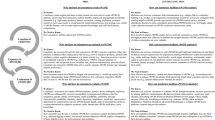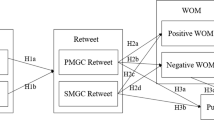Abstract
Given the importance of electronic word-of-mouth (eWOM) in consumer decision making and the great number of possible outlets for eWOM articulation, we focus on why consumers choose a particular eWOM channel. We apply the uses and gratifications approach to channel selection for creating media output. Doing so enables us to explain eWOM channel choice through consumers’ eWOM motives. We find that consumers tend to select eWOM channels that provide gratifications that support their motives for eWOM articulation. These findings can help companies to organize their eWOM management strategies more efficiently and to decide on which channels to focus their efforts.
Similar content being viewed by others
References
Alexander, Cheryl S. and Henry J. Becker (1978), The Use of Vignettes in Survey Research, Public Opinion Quarterly 42 (1), 93–104.
Allsop, Dee T., Bryce R. Bassett, and James A. Hoskins (2007), Word-of-Mouth Research: Principles and Applications, Journal of Advertising 47 (4), 398–411.
Barasch, Alixandra and Jonah Berger (2014), Broadcasting and Narrowcasting: How Audience Size Affects What People Share, Journal of Marketing Research 51 (3), 286–299.
Berger, Jonah A. and Raghuram Iyengar (2013), Communication Channels and Word of Mouth: How the Medium Shapes the Message, Journal of Consumer Research 40 (3), 567–579.
Berger, Jonah and Katherine Milkman (2012), What Makes Online Content Viral?, Journal of Marketing 49 (2), 192–205.
Berger, Jonah and Eric Schwartz (2011), What Drives Immediate and Ongoing Word-of-Mouth?, Journal of Marketing Research 48 (5), 869–880.
Blumler, Jay G. and Elihu Katz (1974), The Uses of Mass Communications: Current Perspectives on Gratifications Research, Beverly Hills: Sage.
Bone, Paula F. (1995), Word-of-mouth Effects on Short-term and Long-term Product Judgments, Journal of Business Research 32 (3), 213–223.
Buhrmester, Michael, Tracy Kwang, and Samuel D. Gosling (2011), Amazon’s Mechanical Turk: A New Source of Inexpensive, yet High-quality, Data?, Perspectives on Psychological Science 6, 1, 3–5.
Chevalier, Judith A. and Dina Mayzlin (2006), The Effect of Word of Mouth on Sales: Online Book Reviews, Journal of Marketing Research 43 (3), 345–354.
Cutler, Neal E. and James A. Danowski (1980), Process Gratification in Aging Cohorts, Journalism Quarterly 57 (2), 269–276.
Dellarocas, Chrysantos (2003), The Digitalization of Word of Mouth: Promise and Challenges of Online Feedback Mechanisms, Management Science 49 (10), 1407–1424.
Dichter, Ernest (1966), How Word-of-Mouth Advertising Works, Harvard Business Review 44 (6), 147–166.
Dobos, Jean (1992), Gratification Models of Satisfaction and Choice of Communication Channels in Organizations, Communication Research 19 (1), 29–51.
Drèze, Xavier and Fred Zufryden (1997), Testing Web Site Design and Promotional Content, Journal of Advertising Research 37 (2), 77–91.
Eighmey, John and Lola McCord (1998), Adding Value in the Information Age: Uses and Gratifications of Sites on the World Wide Web, Journal of Business Research 41 (3), 187–194.
Finch, Janet (1987), The Vignette Technique in Survey Research, Sociology 21 (1), 105–114.
Fong, John and Suzan Burton (2008), A Cross-cultural Comparison of Electronic Word-of-mouth and Country-of-origin Effects, Journal of Business Research 63 (3), 233–242.
Garnefeld, Ina, Sabrina Helm, and Andreas Eggert (2010), Walk Your Talk: An Experimental Investigation of the Relationship Between Word of Mouth and Communicators’ Loyalty, Journal of Service Research 14 (1), 93–107.
Goodman, Joseph K., Chynthia E. Cryder, and Amar Cheema (2012), Data Collection in a Flat World: Strengths and Weaknesses of Mechanical Turk Samples, Journal of Behavioral Decision Making 26 (3), 213–224.
Gupta, Pranjal and Judy Harris (2010), How e-WOM Recommendations Influence Product Consideration and Quality of Choice: A Motivation to Process Information Perspective, Journal of Business Research 63 (9), 1041–1049.
Hair, Joseph F., William C. Black, Barry J. Babin and Rolph E. Anderson (2010), Multivariate Data Analysis — A Global Perspective, (7th ed.), New Jersey: Pearson.
Harrison-Walker, L. Jean (2001), The Measurement of Word-of-Mouth Communication and an Investigation of Service Quality and Customer Commitment as Potential Antecedents, Journal of Service Research 4 (1), 60–75.
Hennig-Thurau, Thorsten, Kevin P. Gwinner, Gianfranco Walsh, and Dwayne D. Gremler (2004), Electronic Word-of-Mouth via Consumer-Opinion Platforms: What Motivates Consumers to Articulate Themselves on the Internet?, Journal of Interactive Marketing 18 (1), 38–52.
Jeong, EunHa and SooCheong Jang (2011). Restaurant Experiences Triggering Positive Electronic Word-of-Mouth (eWOM) Motivations, International Journal of Hospitality Management 30 (2), 356–366.
Hughes, Marie Adele and Dennis E. Garrett (1990), Intercoder Reliability Estimation Approaches in Marketing: A Generalizability Theory Framework for Quantitative Data, Journal of Marketing Research 27 (2), 185–195.
Kaplan, Andreas M. and Michael Haenlein (2010), Users of the World, Unite! The Challenges and Opportunities of Social Media, Business Horizons 53 (1), 59–68.
Keller, Ed (2007), Unleashing the Power of WOM: Creating Brand Advocacy to Drive Growth, Journal of Advertising Research 47 (4), 448–452.
Kink, Natalie and Thomas Hess (2008), Search Engines as Substitutes for Traditional Information Sources? An Investigation of Media Choice, The Information Society 24 (1), 18–29.
Litvin, Stephen W., Ronald E. Goldsmith, and Bing Pan (2008), Electronic Word-of-Mouth in Hospitality and Tourism Management, Tourism Management 29 (3), 458–468.
Liu, Yong (2006), Word of Mouth for Movies: Its Dynamics and Impact on Box Office Revenue, Journal of Marketing 70 (3), 74–89.
Lovett, Mitchell J., Renata Peres, and Ron Shanchar (2013), On Brands and Word of Mouth, Journal of Marketing Research 50 (4), 427–444.
MacCallum, Robert C., Michael W. Browne, and Hazuki M. Sugawara (1996), Power Analysis and Determination of Sample Size for Covariance Structure Modeling, Psychological Methods 1 (2), 130–49.
Mattila, Anna S. and Joc hen Wirtz (2004), Consumer Complaining to Firms: the Determinants of Channel Choice, Journal of Services Marketing 18 (2), 147–155.
Nunnally, J. C. (1978), Psychometric Theory (2nd ed.), New York: McGraw-Hill.
Nyer, Prashanth U. and Mahesh Gopinath (2005), Effects of Complaining versus Negative Word of Mouth on Subsequent Changes in Satisfaction: The Role of Public Commitment, Psychology & Marketing 22 (12), 937–953.
Palmgreen, Philipp, Lawrence A. Wenner, and Jay D. Rayburn (1980), Communication Research 7 (2), 161–192.
Raacke, John and Jennifer Bonds-Raacke (2008), MySpace and Facebook: Applying the Uses and Gratifications Theory to Exploring Friend-Networking Sites, CyberPsychology & Behavior 11 (2), 169–74.
Rubin, Alan M. (1983), Television Uses and Gratifications: The Interactions of Viewing Patterns and Motivations, Journal of Broadcasting 27 (1), 58–84.
Rubin, Alan M (2009), Uses-and-Gratifications Perspective of Media Effects, in Media Effects: Advances in Theory and Research (3rd ed.), Mary B. Oliver and Jennings Bryant, (eds.) New York: Routledge, 165–184.
Sepp, Marianne, Veronica Liljander, and Johanna Gummerus (2011), Private Bloggers’ Motivation to Produce Content — A Gratifications Theory Perspective, Journal of Marketing Management 27 (13–14), 1479–1530.
Shimp, Terence A., Eva Hyatt, and David J. Snyder (1991), A Critical Appraisal of Demand Artifacts in Consumer Research, Journal of Consumer Research 18 (3), 273–283.
Smith, Andrew N., Eileen Fischer, and Chen Yongjian (2012), How does Brand-related User-generated Content Differ across YouTube, Facebook, and Twitter?, Journal of Interactive Marketing 26 (2), 102–113.
Song, Indeok, Robert Larose, Mathew S. Eastin, and Carolyn A. Lin (2004), Internet Gratifications and Internet Addiction: On the Uses and Abuses of New Media, CyberPsychology & Behavior 7 (4), 384–394.
Stafford, Thomas F., Marla Royne Stafford, and Lawrence L. Schkade (2004), Determining Uses and Gratifications for the Internet, Decision Sciences 35 (2), 259–288.
Sundaram, Dorai S., Mitra Kaushik, and Cynthia Webster (1998), Word-of-Mouth Communications: A Motivational Analysis, Advances in Consumer Research 25 (1), 527–531.
Sweetser, Kay D., Lance V. Porter, Deborah Soun C., and Eunseong Kim (2008), Credibility and the Use of Blogs Among Professionals in the Communication Industry, J&MC Quarterly 85 (1), 169–185.
Toubia, Olivier and Andrew T. Stephen (2013), Intrinsic vs. Image-Related Utility in Social Media: Why Do People Contribute Content to Twitter?, Marketing Science, 32 (3), 368–392.
Toyota Press Release (2013), Rekordjahr für Toyota, Retrieved October 8, 2014, from details-2013-06.json
Tufekci, Zeynep (2008), Grooming, Gossip, Facebook, and MySpace, Information, Communication and Society 11 (4), 544–564.
Urista, Mark A., Dong Qingwen, and Kenneth D. Day (2009), Explaining Why Young Adults Use MySpace and Facebook Through Uses and Gratifications Theory, Human Communication 12 (2), 215–229.
Villanueva, Julian, Shijin Yoo, and Dominique M. Hanssens (2008), The Impact of Marketer-Induced Versus Word-of-Mouth Customer Acquisition on Customer Equity Growth, Journal of Marketing Research 45 (1), 48–59.
Wojnicki, Andrea and David Godes (2011), Signaling Success: Strategically Positive Word of Mouth, Working Paper, Harvard Business School.
Yoo, Kyung Hyan and Ulrike Gretzel (2008), What Motivates Consumers to Write Online Travel Reviews, Information Technology & Tourism 10, 4, 283–295.
Zhu, Feng and Xiaoguan Zhang (2010), Impact of Online Consumer Reviews on Sales: The Moderating Role of Product and Consumer Characteristics, Journal of Marketing 74 (2), 133–148.
Author information
Authors and Affiliations
Corresponding author
Additional information
The authors would like to thank Sibel Siray and Alexander Mafael, as well as two anonymous reviewers and the editors for their valuable feedback on earlier versions of this paper.
Rights and permissions
About this article
Cite this article
Kreis, H., Gottschalk, S.A. Relating eWOM Motives to eWOM Channel Choice — Why Do We Post Where We Do?. Schmalenbach Bus Rev 67, 406–429 (2015). https://doi.org/10.1007/BF03396927
Published:
Issue Date:
DOI: https://doi.org/10.1007/BF03396927




